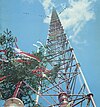Sidelobes
This article does not cite any sources. (April 2008) |


| Part of a series on |
| Antennas |
|---|
 |
In antenna engineering, sidelobes are the lobes (local maxima) of the far field radiation pattern of an antenna or other radiation source, that are not the main lobe.
The radiation pattern of most antennas shows a pattern of "lobes" at various angles, directions where the radiated signal strength reaches a maximum, separated by "nulls", angles at which the radiated signal strength falls to zero. This can be viewed as the diffraction pattern of the antenna. In a directional antenna in which the objective is to emit the radio waves in one direction, the lobe in that direction is designed to have a larger field strength than the others; this is the "main lobe". The other lobes are called "sidelobes", and usually represent unwanted radiation in undesired directions. The sidelobe directly behind the main lobe is called the back lobe. The longer the antenna relative to the radio wavelength, the more lobes its radiation pattern has. In transmitting antennas, excessive sidelobe radiation wastes energy and may cause interference to other equipment. Another disadvantage is that confidential information may be picked up by unintended receivers. In receiving antennas, sidelobes may pick up interfering signals, and increase the noise level in the receiver.
The power density in the sidelobes is generally much less than that in the main beam. It is generally desirable to minimize the sidelobe level (SLL), which is measured in decibels relative to the peak of the main beam. The main lobe and sidelobes occur for both transmitting and receiving. The concepts of main and sidelobes, radiation pattern, aperture shapes, and aperture weighting, apply to optics (another branch of electromagnetics) and in acoustics fields such as loudspeaker and sonar design, as well as antenna design.
Because an antenna's far field radiation pattern is a Fourier Transform of its aperture distribution, most antennas will generally have sidelobes, unless the aperture distribution is a Gaussian, or if the antenna is so small as to have no sidelobes in the visible space. Larger antennas have narrower main beams, as well as narrower sidelobes. Hence, larger antennas have more sidelobes in the visible space (as the antenna size is increased, sidelobes move from the evanescent space to the visible space).
Sidelobes for case of uniformly-illuminated aperture[]
For a rectangular aperture antenna having a uniform amplitude distribution (or uniform weighting), the first sidelobe is −13.26 dB relative to the peak of the main beam. For such antennas the radiation pattern has a canonical form of
-
(1)
Simple substitutions of various values of X into the canonical equation yield the following results:
| X | Radiation Pattern | Explanation |
|---|---|---|
| 0 | 0 dB | peak of main beam |
| −∞ dB | first null | |
| −13.26 dB | peak of first sidelobe | |
| −∞ dB | second null | |
| −17.83 dB | peak of second sidelobe |
For a circular aperture antenna, also having a uniform amplitude distribution, the first sidelobe level is −17.57 dB relative to the peak of the main beam. In this case, the radiation pattern has a canonical form of
-
(2)
where is the Bessel function of the first kind of order 1. This is known as the Airy pattern. Simple substitutions of various values of X into the canonical equation yield the following results:
| X | Radiation Pattern | Explanation |
|---|---|---|
| 0 | 0 dB | peak of main beam |
| 3.83 | −∞ dB | first null |
| 5.14 | −17.57 dB | peak of first sidelobe |
| 7.02 | −∞ dB | second null |
| 8.42 | −23.81 dB | peak of second sidelobe |
A uniform aperture distribution, as provided in the two examples above, gives the maximum possible directivity for a given aperture size, but it also produces the maximum sidelobe level. Sidelobe levels can be reduced by tapering the edges of the aperture distribution (changing from uniformity) at the expense of reduced directivity.
The nulls between sidelobes occur when the radiation patterns passes through the origin in the complex plane. Hence, adjacent sidelobes are generally 180° out of phase to each other.
External links[]
- Antennas
- Radio frequency propagation






